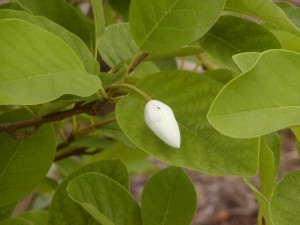Here are some ideas for designing a tropical landscape in your yard. Start with large leafy trees that are hardy in zones 6-7 include catalpa (Catalpa spp.), hickories (Carya spp.), some oaks (Quercus spp.), large leaf maple (Acer macrophylla), American sycamore (Platanus americana), American linden (Tilia americana), and Empress tree (Paulownia tomentosa). In zones 7-9 […]
Archive for the ‘Magnolia’ Category
Enormous Leaves On Sapling Trees
Some fast-growing trees like Royal Empress tree (Paulownia tomentosum) smoketree (Cotinus coggygria), and basswood linden (Tilia americana). There are lots more arboreal candidates. Keep the young tree saplings vegetative by practicing “Renewal Pruning”. To create an accent tree, single or multi-stemmed, wait until the plant has been in the ground for a few years, then begin […]
Ashe Magnolia
Ashe magnolia (Magnolia macrophylla subsp. Ashei) is a small 10-20 feet tree with enormous leaf and flower sizes (zone (5)6-9). Anindividual white flower measures 6- 12 inches across with a purple blotch at the base of 3 inner petal-like tepals. Ashe magnolia blooms in late May – early June in Tennessee. Many of the white […]
Yellow Flowering Magnolias
Deciduous magnolias (Magnolia spp.) are popular landscape plants because of their bright cheery spring flowers. Breeding efforts back in the 1970’s created a new class of deciduous yellow-flowering magnolias. In 1978, the Brooklyn Botanical Gardens introduced the first, Magnolia ‘Elizabeth’ (creamy white). Yellow magnolias are hybrid crosses between M. acuminata, M. subcordata, M. denudata, among […]
Plant Disease Warning: Phytophthora ramorum
Known as “sudden oak death”, this serious plant disease (Phytophthora ramorum) (Pr) from the West Coast kills oak and other species of trees. It has caused devastating effects on the oak populations in California, Oregon, and Washington, and is also present in Europe. Symptoms include bleeding cankers on the tree’s trunk and dieback of foliage. […]
Planting Small Trees Under Power Lines
Look Up before you plant. From city streets to country roadside are a myriad of power (utility) lines, e.g. electric, telephone, and cable TV wires. Utility companies have a “right of away” clearance to operate their lines. In most municipalities, mature trees growing into their lines can be cut down or all offending branches removed. Large trees often end […]
Saucer Magnolias
Saucer magnolias (M. x soulangeana) are deciduous hybrid magnolias (M. denudata x M. liliiflora) as broad shrubs or small trees. They typically grow 20-30 feet in height and width. Saucer magnolias are often called tulip magnolias because of the shape of the colorful blooms. Flower colors range from white, pink, rose, purple, magenta, and burgundy. Flowers […]
Early Flowering Magnolias
If you live (and garden) in the northern climes of the U.S. and Canada, Magnolia ×loebneri Leonard Messel is an excellent choice of a flowering yard tree. It is a hybrid deciduous magnolia (M. kobus x M. stellata) (zones (4)5-9). Other similar crosses include ‘Ballerini’ and ‘Merrill’. Leonard Messel magnolia grows to 20-30 feet tall with a rounded crown. It is […]
Our Native Bigleaf Magnolias
Bigleaf magnolias are represented by four species: (M. macrophylla), umbrella magnolia (M. tripetala), Fraser magnolia (M. fraseri), and Ashe magnolia (M. ashei). All are medium-size trees with huge leaves and large flowers that appear after the leaves unfurl. All are native to the southeastern United States as far north to West Virginia and Ohio (USDA hardiness zones […]
Summer Blooming Oyama Magnolia

A friend on vacation sent me the attached photo from Wooster, Ohio. When I told him that it was Oyama magnolia (Magnolia sieboldii), he asked why gardeners are not growing it. Good question! Oyama magnolia is a 10-15 feet tall (and equal spread) deciduous tree or large shrub from eastern Asia. It prefers to grow […]

 Posted in
Posted in 

